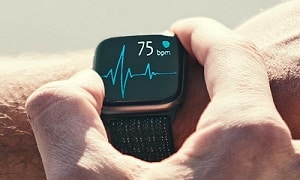The wearable includes a range of sensors and ICs that allows collection of blood oxygen, ECG, heart rate, body temperature and activity data
 Now you can save at least six months of development time using the Health Sensor Platform 3.0 (HSP 3.0) from Maxim Integrated. Also known as MAXREFDES104#, this ready-to-wear wrist form factor reference design monitors blood oxygen saturation (SpO2), electrocardiogram (ECG), heart rate (HR), body temperature and motion. Included algorithms provide HR, heart-rate variability (HRV), respiration rate (RR), SpO2, body temperature, sleep quality and stress level information at clinical-grade levels, allowing wearable designers to start collecting data immediately.
Now you can save at least six months of development time using the Health Sensor Platform 3.0 (HSP 3.0) from Maxim Integrated. Also known as MAXREFDES104#, this ready-to-wear wrist form factor reference design monitors blood oxygen saturation (SpO2), electrocardiogram (ECG), heart rate (HR), body temperature and motion. Included algorithms provide HR, heart-rate variability (HRV), respiration rate (RR), SpO2, body temperature, sleep quality and stress level information at clinical-grade levels, allowing wearable designers to start collecting data immediately.
Designed for wrist-based form factors, HSP 3.0 can be adapted for other dry electrode form factors such as chest patches and smart rings.
Improved Enhancements
The HSP 3.0 includes an optical SpO2 measurement and dry-electrode capability to the ECG. As a result, end solutions can monitor cardiac heart and respiratory issues such as chronic obstructive pulmonary disease (COPD), COVID-19, sleep apnea and atrial fibrillation (AFib). Compared to its predecessor, the HSP 2,0, a narrower form factor and enhanced optical architecture of HSP 3.0 improves signal acquisition quality and uses upgraded microcontroller, power, security and sensing ICs. The reference design includes complete optical and electrode designs, along with algorithms to meet clinical requirements.
As more sensing modalities are included in wearables, device developers can take advantage of multiple measurements to improve the accuracy of the actionable insights that are being provided to users.
Range of ICs integrated
HSP 3.0 or MAXREFDES104# includes the following sensor, power management, microcontroller and algorithm products:
- MAX86176: Low-noise optical photoplethysmography (PPG) and electrical ECG analogue front end (AFE), which offers 110dB signal-to-noise ratio (SNR) to add SpO2 saturation capability and over 110dB common-mode rejection ratio (CMRR) for dry electrode ECG applications. The device enables synchronous acquisition of PPG and ECG measurements, even with independent sample rates, providing pulse transit time for cardiac health use cases.
- MAX20360: Highly integrated power and battery management power management IC (PMIC) optimised for advanced body-worn health sensing devices. It includes a high-accuracy ModelGauge m5 EZ fuel gauge, a sophisticated haptic driver and a unique low-noise buck-boost converter that maximizes SNR and minimises power used for optical bio-sensing.
- MAX32666: Bluetooth (BLE)-enabled, ultra-low-power microcontroller with two Arm Cortex-M4F cores and an additional SmartDMA, which permits running the BLE stack independently, leaving the two main cores available for major tasks. Moreover, the microcontroller integrates an entire security suite and error-correcting code (ECC) on the memories to significantly increase the system’s robustness.
- MAX32670: Ultra-low-power microcontroller for PPG algorithms of pulse rate, SpO2, HRV, RR, sleep quality monitoring and stress monitoring. It can be configured either as a sensor hub to support firmware and algorithms or as an algorithm hub to support multiple algorithms. The MAX32670 seamlessly enables customer-desired sensor functionality, including managing the MAX86176 PPG and ECG sensor AFE as well as delivering either raw or calculated data to the outside world.
- MAX30208: The low-power, high-accuracy digital temperature sensor comes in a small package size of 2mm x 2mm. It has 33 per cent lower operating current compared to the closest competitive solution. It reads the temperature on the top of the package and can be mounted on a flex cable or PCB, making it easier to design into wearables. With an accuracy of 0.1-degrees Celsius, the MAX30208 meets clinical temperature requirements.
“Remote patient monitoring of vital signs is more important than ever,” said Dr Nadia Tsao, principal analyst at IDTechEx. “The pandemic has rapidly accelerated the uptake of digital health services such as telehealth and remote patient monitoring, up to 1,000 per cent in some cases. Going forward, remote patient monitoring is going to be critical for preventative health and chronic disease management.”
“During these times of the pandemic, there’s a drive towards a point of use to monitor clinical-grade measurements such as SpO2, respiration and temperature,” said Andrew Baker, managing director for the Industrial and Healthcare Business Unit at Maxim Integrated. “Developers strive to continue this momentum of remote patient monitoring by creating innovative solutions to provide deeper insight into health conditions, open doors to improve wellness and minimise the amount of time people need to visit healthcare facilities.”
HSP 3.0, also known as MAXREFDES104#, is available with hardware, firmware and algorithms at Maxim Integrated’s website.







